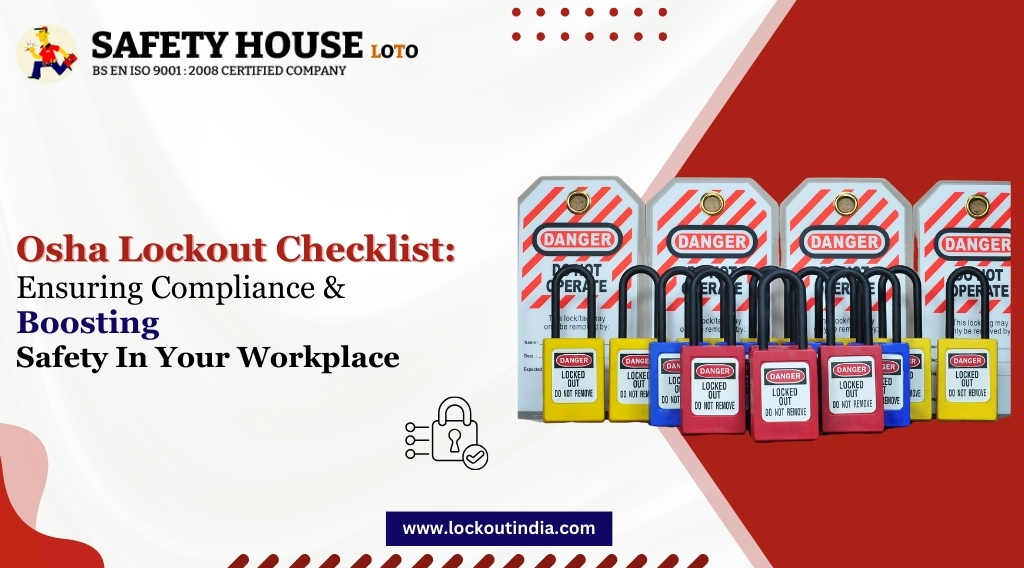
OSHA Lockout Checklist: Ensuring Compliance and Boosting Safety in Your Workplace
OSHA Lockout Checklist for Workplace Safety
Introduction:
In today’s industrial landscape, prioritizing safety measures is paramount to ensure the well-being of workers and compliance with regulatory standards. The Occupational Safety and Health Administration (OSHA) plays a crucial role in setting guidelines and regulations to maintain workplace safety. One such vital aspect regulated by OSHA is lockout procedures, aimed at preventing hazardous energy releases during maintenance or servicing activities. This article delves into the significance of OSHA lockout procedures, the importance of compliance, and how implementing a comprehensive lockout checklist can bolster safety in the workplace.
Understanding OSHA Lockout:
OSHA lockout refers to the set of procedures designed to control hazardous energy sources, such as electrical, mechanical, hydraulic, pneumatic, chemical, and thermal energy, to prevent unexpected startup or release of stored energy. These procedures mandate the use of lockout devices to isolate energy sources and ensure equipment remains inoperative during maintenance or repair tasks. Adhering to OSHA standards not only mitigates the risk of workplace accidents but also fosters a culture of safety within the organization.
The Importance of OSHA Lockout Compliance:
Compliance with OSHA lockout regulations is non-negotiable for businesses operating in industrial settings. Failure to adhere to these standards can result in severe consequences, including fines, penalties, and, most importantly, jeopardizing the safety of workers. By complying with OSHA lock requirements, companies demonstrate their commitment to workplace safety, protecting employees from potential hazards and ensuring regulatory adherence.
Key Elements of an OSHA Lockout Checklist:
Creating and implementing an OSHA lockout checklist is instrumental in ensuring compliance and enhancing safety protocols within the workplace. Below are the key elements to include in a comprehensive lockout checklist:
- Identification of Energy Sources: Begin by identifying all energy sources present in the workplace, including electrical, mechanical, and pneumatic systems. Conduct a thorough assessment to pinpoint potential hazards and determine the necessary lockout procedures for each energy source.
2. Lockout Device Selection: Select appropriate lockout devices suitable for isolating each energy source effectively. Ensure lockout devices are durable, tamper-resistant, and compatible with the equipment being serviced.
3. Employee Training and Awareness: Provide comprehensive training to employees on OSHA lockout procedures, emphasizing the importance of proper lockout/tagout (LOTO) practices. Employees should be proficient in identifying energy sources, applying lockout devices, and understanding the significance of LOTO protocols for their safety.
4. Documentation and Procedures: Develop clear and concise lockout/tagout procedures outlining step-by-step instructions for implementing lockout measures. Maintain detailed documentation of lockout procedures, including equipment-specific instructions and authorized personnel responsible for performing lockout tasks.
5. Periodic Inspections and Audits: Conduct regular inspections and audits to ensure compliance with lockout procedures and identify any deviations or shortcomings. Address any deficiencies promptly and revise lockout procedures as necessary to maintain effectiveness.
6. Communication and Signage: Implement clear communication protocols and signage to alert employees of ongoing lockout activities and the status of equipment undergoing maintenance. Use standardized lockout tags and labels to indicate the presence of lockout devices and provide instructions for safe operation.
Benefits of Implementing an OSHA Lockout Checklist:
Implementing an OSHA lockout checklist offers numerous benefits for businesses, including:
- Enhanced Workplace Safety: By following standardized lockout procedures, businesses can effectively control hazardous energy sources and reduce the risk of workplace accidents.
- Compliance with Regulatory Standards: Adhering to OSHA lockout regulations ensures compliance with legal requirements, mitigating the risk of fines and penalties.
- Prevention of Equipment Damage: Proper lockout procedures prevent unauthorized operation of equipment during maintenance, minimizing the risk of damage or malfunction.
- Protection of Personnel: Lockout procedures safeguard workers from potential injuries caused by unexpected energy releases or equipment startup.
- Establishment of Safety Culture: Implementing robust lockout protocols fosters a culture of safety within the organization, promoting awareness and accountability among employees.
Conclusion:
In conclusion, OSHA lockout procedures are critical for maintaining workplace safety and compliance with regulatory standards. Implementing an OSHA lockout checklist is essential for identifying energy sources, selecting appropriate lockout devices, providing employee training, documenting procedures, conducting inspections, and fostering effective communication. By prioritizing OSHA lockout compliance and integrating comprehensive lockout protocols, businesses can mitigate risks, protect personnel, and promote a culture of safety in the workplace. Remember, safety is paramount, and adherence to OSHA lockout standards is key to ensuring a secure and productive work environment.

Elements Of OSHA’s Lockout-Tagout Standard
The elements of Osha Lockout Tagout Standard (29 CFR 1910.147) is a 4-page general industry standard, which was first published in 1989. It was formulated with the single aim of preventing accidental startups of machineries and equipments during their maintenance or service. It lays importance on isolating hazardous energy sources and rendering them isolated. The energy sources include hydraulic, thermal, electrical (stored and active current), chemical, gravitational force, pneumatic and mechanical.
A lockout/tagout program includes 3 basic elements:
1. Written Procedures: These written procedures communicate important information workers involved in lockout/tagout procedures and identify what needs to be done and when. They also prescribe the processes of shutdown, isolation and applying and removing lockout/tagout. Such procedures are only needed for machineries with 2 or more energy sources.
The following should be clearly specified:
– Specific machineries and their shutdown/isolation processes
– Where the lockout devices are installed
– How to de-energize stored energy
– How isolation needs to be verified
2. Training Programs: Training is mandatory for two types of employees, namely authorized employees and affected employees, where the former the people who maintain and service machineries and are qualified enough to control hazardous energies, and the latter are those work in close proximity to the machines/equipments being serviced or repaired under lockout/tagout and need to understand the hazards involved.
3. Timely Audits: Periodic audits ensure that the energy control procedures continue to be correctly implemented, the workforce do not deviate from the procedures and are familiar with their responsibilities. It must take place at least annually. These are also helpful in correcting procedural inadequacies.
Basic steps to lockout/tagout program:
1. Preparation – Think and Plan: Think through the entire procedure. Identify the energy sources that must be controlled and the methods which would be used.
2. Communicate and Notify: The authorized personnel needs to communicate the following to the affected employees:
– The machine that would be locked out and why
– How long will the process take
– Name of the employee responsible for lockout
– Who needs to be contacted for further information
3. Neutralizing the Equipments: It involves disconnecting the electricity, blocking the movable parts, releasing the spring energy, draining or bleeding hydraulic/pneumatic lines and lowering the suspended parts to rest positions.
4. Locking Out: Use lockout devices specific to the machinery. There should be as many locks as the people involved in the process and each person should have a personal lock and key placed on the machinery. Further, it should be noted that locks can only be unlocked by those who installed them.
5. Tagging Out: Tag the machineries, controls, and suspended parts. Tags should also include the contact details of and reasons for locking out.
Verify: Before you continue further, verify if the setup is completely locked out or not.
Checkout Our Other Lockout Tagout Products:
- Scaffold Tag
- MCB Lockout
- Lockout Padlocks
Enquire Now

